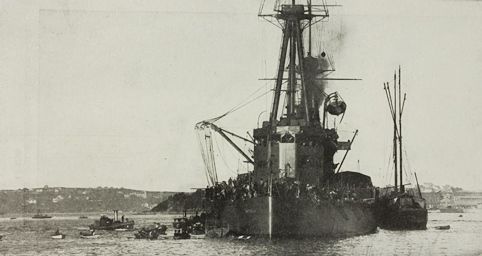
While everyone had been aware of the storm clouds brewing in the wake of the assassination of Archduke Ferdinand in Serbia at the end of July the news from London, paraphrased in the following quote from Bairnsdale Advertiser, fell like a bolt from the blue … EUROPEAN CRISIS. WAR INEVITABLE, A great crisis has occurred. in Europe owing to the action of Austria in delivering an ultimatum to Serbia and the Russian demands being refused. It is considered that war must be proclaimed straightaway. There are strong, probabilities that other powers wilt become embroiled unless the situation is handled very carefully.
Although there was an absence of definite news from the British Admiralty the countermanding of the dispersal of the ‘First Fleet’ and retention of the ‘Second Fleet’ made it clear that not only was war practically certain in Eastern Europe but the possibility of its spread was great enough the justify the British Navy’s precautions. On 30 July Admiral Patey called the squadron south in preparation for war. On 5 August the news finally arrived that war had broken out between Britain and Germany and within a few hours the whole machinery of Australia’s Naval defence was in operation. Wireless interceptions around this time located several big German cruisers in the vicinity of Australia, possibly around the Bismarck Archipelago near German New Guinea.
All the warships except the Encounter and Pioneer and the submarines were on their way to their war stations but on the basis of the wireless information it was decided to send, the Australia, Sydney, Encounter, and the three destroyers, including the Parramatta to attack the base at Simpson Harbour, in German New Guinea.
The squadron, minus the Encounter and Melbourne met on 9 August and reached their destination on the 11 August. At the time there was the possibility of five ships being in harbour and a plan of engagement was distributed to all the captains, if there were no ships it would be up to the destroyers, painted black while at Thursday island, to slip into the harbour, land party and destroy the wireless telegraph station reported to be at Rabaul. At 9 pm the destroyers entered the harbour, the Sydney waited about three miles off Praed Point, the Yarra turned north into Matupi Harbour – the Worrego and the Parramatta made straight for the western side of Simpson Harbour and the wharves at Rabaul.
The night was exceptionally dark and it was only once they reached the jetty that they realised the harbour was empty of any warships, they returned to the Sydney and once there search of the entire area confirmed there were no warship nearby they proceeded to the second part of the plan. At about 9 am on 12 August an armed party made an official landing at Rabaul with the intention of destroying the telegraph station.
Commander Cumberlege was in charge of the armed party, and cross examined Tolke, the local district officer. Tolke informed them that there was no resistance but neglected to tell the Australians an ‘‘ expeditionary force ” had been organised some days before to defend the wireless station at Bitapaka, and the local militia was camping at Blanche Bay, where the roads from Herbertshohe and Talili Bay join at the approach to Rabaul. Even though they picked up messages from it the Australians were unable to find the telegraph station. Running short of coal and oil they destroyed the Rabaul Post Office equipment and left. A hastily raised force known as the Australian Naval and Military Expeditionary Force would be dispatched to seize German possessions in the Pacific in September but this was the first Australian engagement of the First World War.
References
The Royal Australian Navy, The Official History of Australian the War of 1914-1918, Volume 9, Charles Bean, Angus and Robertson, 1941



